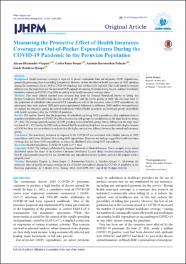| dc.contributor.author | Hernández-Vásquez, Akram | es_ES |
| dc.contributor.author | Rojas-Roque, Carlos | es_ES |
| dc.contributor.author | Barrenechea-Pulache, Antonio | es_ES |
| dc.contributor.author | Guido Bendezú-Quispe | es_ES |
| dc.date.accessioned | 2023-02-06T15:50:20Z | |
| dc.date.available | 2023-02-06T15:50:20Z | |
| dc.date.issued | 2021-11-07 | |
| dc.identifier.uri | https://hdl.handle.net/20.500.13053/7749 | |
| dc.description.abstract | Abstract
Background: Health insurance coverage is expected to protect individuals from out-of-pocket (OOP) expenditures,
potentially preventing them from falling into poverty. However, to date, the effect of health insurance on OOP spending
during the coronavirus disease 2019 (COVID-19) pandemic has not been fully explored. This study aimed to estimate
differences in the proportion and the amount of OOP expenditures among Peruvians during the pre- and post-mandatory
lockdown response to COVID-19 in 2020 according to the health insurance coverage status.
Methods: This study utilized repeated cross-sectional data from the National Household Survey on Living and
Poverty Conditions (ENAHO) from the first quarter of 2017 until the fourth quarter of 2020. The outcomes were (i)
the proportion of individuals who incurred OOP expenditures and (ii) the monetary value of OOP expenditures. An
interrupted time series analysis (ITS) and a quasi-experimental difference-in-difference (DID) analysis were performed
to examine the outcomes among the control (individuals without health insurance) and treatment groups (individuals
with health insurance) after the COVID-19 pandemic.
Results: ITS analysis showed that the proportion of individuals reporting OOP expenditures after implementation of
mandatory lockdown due to COVID-19 in Peru decreased in both groups, but no difference in the slope trend was found
(P=.916). The average quarterly amount of OOP spending increased in both groups, but no difference in the slope trend
was found (P=.073). Lastly, the DID analysis showed that the mandatory lockdown was associated with a higher amount
of OOP, but there was no evidence to indicate that the higher amount was different between the control and treatment
groups.
Conclusion: The mandatory lockdown in response to the COVID-19 was associated with a higher amount of OOP
expenditures and a lower likelihood of incurring OOP expenditures. However, our findings suggest that health insurance
coverage does not lower OOP expenditures or reduce the likelihood of incurring OOP expenditures. | es_ES |
| dc.format | application/pdf | es_ES |
| dc.language.iso | eng | es_ES |
| dc.publisher | Kerman University of Medical Sciences | es_ES |
| dc.rights | info:eu-repo/semantics/openAccess | es_ES |
| dc.rights.uri | https://creativecommons.org/licenses/by/4.0/ | es_ES |
| dc.subject | El gasto en salud COVID-19 SARS-CoV-2 Perú | es_ES |
| dc.title | Measuring the Protective Effect of Health Insurance Coverage on Out-of-Pocket Expenditures During the COVID-19 Pandemic in the Peruvian Population | es_ES |
| dc.type | info:eu-repo/semantics/article | es_ES |
| dc.identifier.doi | 10.34172/IJHPM.2021.154 | es_ES |
| dc.type.version | info:eu-repo/semantics/publishedVersion | es_ES |
| dc.publisher.country | IR | es_ES |
| dc.subject.ocde | http://purl.org/pe-repo/ocde/ford#3.03.00 | es_ES |


